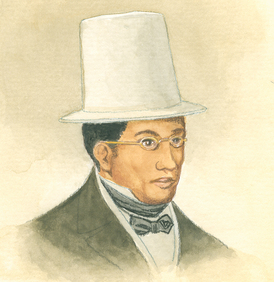David Ruggles Home
David Ruggles might have been the most hated activist of his day. One slave catcher screamed that he would give "a thousand dollars if I had …Ruggles in my hands as he is the leader." And Ruggles was just that—a leader against slavery. He came to New York around 1827 from Connecticut, where he was born free. When he arrived he was 17 years old—and fearless, determined, and educated.
The year 1827 was a time of parades celebrating the end of slavery in New York. More and more runaways were arriving from the South every day. But right behind them were the slave catchers. Called "blackbirders," they roamed the streets looking to reclaim some of the runaways and even to kidnap free blacks. No black person was safe. Ruggles saw how dangerous the city was and decided to do something about it.
In 1835, he and several other young black activists founded the New York Committee of Vigilance. Ruggles and the rest of the Committee protected runaways and confronted the slave catchers. He made the city government grant jury trials to slaves who were recaptured, and he obtained lawyers for them. He personally helped as many as 600 fugitives, including the now-famous Frederick Douglass. He also ran an antislavery bookstore until it was destroyed by a mob. In addition, he wrote hundreds of articles. He bought a printing press and published his own pamphlets and a magazine called Mirror of Liberty. It was the first periodical published by a black American. But after 20 years of activism, Ruggles was nearly blind and seriously ill. Many, including Frederick Douglass, came to his aid. Ruggles died in Massachusetts in 1849.
This entry contributed by
Curriculum Concepts International
Related Media
Images

|
Ruggles sheltered runaway Frederick Douglass here at 36 Lispenard Street. He also ran a boarding house at 67 Lispenard that was a meeting place for abolitionists.
|

|
David Ruggles was the leading, and possibly the most hated, abolitionist in New York City. His courage, activism, and writings made the city a safer place for fugitives and free blacks.
|

|
This title page reads: The first annual report of the New York Committee of Vigilance for the year 1837 : together with important facts relative to their proceedings.
|
